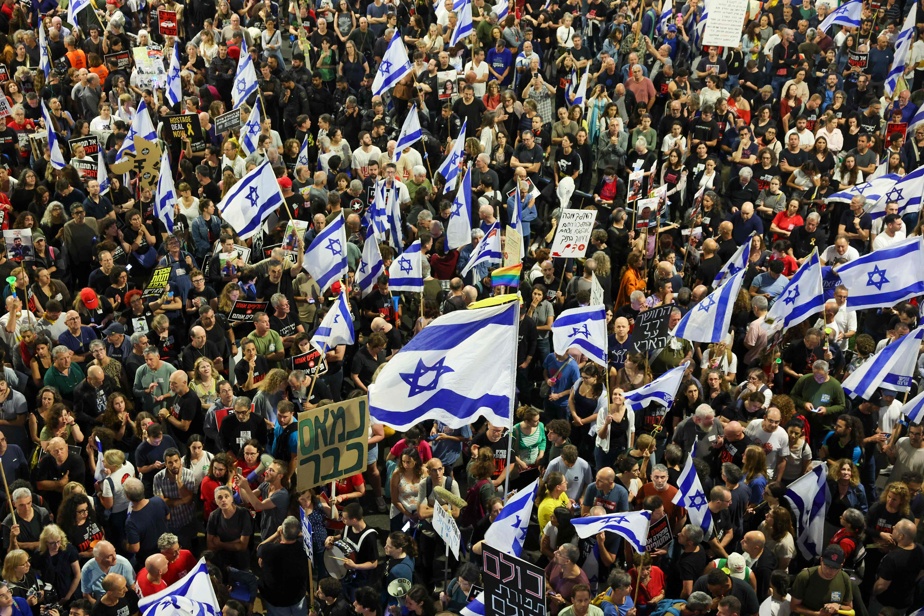(Jerusalem) Diplomatic efforts for a truce in the fighting in Gaza combined with the release of hostages intensify on Sunday, as Hamas studies an Israeli counter-proposal for a ceasefire in the territory Palestinian under siege and threatened with famine.
Nearly seven months after the start of the war, triggered by the bloody attack by the Palestinian Islamist movement against Israel on October 7, the Israeli army indicated on Sunday that it had struck “dozens of terrorist targets” in central Gaza.
At the same time, it is preparing to launch a ground offensive in Rafah, where there are a million and a half Palestinians, mainly displaced people. Many capitals and humanitarian organizations fear a bloodbath in this city already regularly bombarded by the Israeli army.
From Saudi Arabia, where a special meeting of the World Economic Forum (WEF) is being held from Sunday, the President of the Palestinian Authority, Mahmoud Abbas, called on the United States to prevent a ground invasion in Gaza.
If it were to take place, the operation would be the “greatest disaster in the history of the Palestinian people,” he said.
US Secretary of State Antony Blinken is also expected in Riyadh, Saudi Arabia, where he will discuss “ongoing efforts to achieve a ceasefire in Gaza that allows for the release of the hostages”, and will also “put emphasis on the importance of preventing a regional extension of the war, the State Department said Saturday.
The fear of a regional extension of the conflict, particularly with neighboring Lebanon, is also on the agenda for a meeting on Sunday in Beirut between the French Minister of Foreign Affairs, Stéphane Séjourné, and Lebanese officials.
“A deal now”
These diplomatic negotiations are taking place at a time when Hamas says it is “studying” an Israeli counter-proposal with a view to a truce, associated with the release of the hostages. The Islamist movement, in power in Gaza since 2007, indicated on Saturday that it “will submit its response once its study is completed”.
A Hamas delegation will arrive in Egypt on Monday to submit its response to the recent Israeli counter-proposal, a senior official of the Palestinian movement announced to AFP.
The delegation will be led by Khalil al-Hayya, the number 2 of Hamas’ political branch for Gaza and will meet the director and officials of the Egyptian intelligence service, said this senior official on condition of anonymity.
The details of the counter-proposal have not filtered out, but according to the Axios site, which cites Israeli officials, it includes the desire to discuss “the establishment of lasting calm” in Gaza.
Meanwhile, internal pressure on Benjamin Netanyahu’s government continues to increase. On Saturday evening, thousands of people gathered in Tel Aviv to demand the release of hostages kidnapped on October 7.

PHOTO OHAD ZWIGENBERG, ASSOCIATED PRESS
Demonstration in Tel Aviv, Saturday evening
That day, Hamas commandos carried out an unprecedented attack on Israel resulting in the deaths of 1,170 people, mainly civilians, according to an AFP report based on official Israeli data. More than 250 people have been kidnapped and 129 remain captive in Gaza, 34 of whom have died according to Israeli officials.
In retaliation, Israel vowed to annihilate Hamas, which it considers a terrorist organization, as well as the United States and the European Union. Its offensive in Gaza left 34,454 dead, mostly civilians, according to a new report from the Hamas Ministry of Health on Sunday.
“A deal, now!” » chanted the demonstrators on Saturday evening, while calling on the Netanyahu government to resign. Shortly before, Hamas released a video showing two hostages, Keith Siegel, 64, and Omri Miran, 47. This is the second video released in several days by Hamas.
At the rally in Tel Aviv, Mr Miran’s father urged Hamas to “show humanity”, also asking it to “make a decision now”.
Strikes and artillery fire
In the meantime, the war shows no sign of abating. Throughout Saturday, the Israeli navy targeted Hamas targets and provided support to troops deployed in the center of the territory, the army said Sunday.
According to an AFP correspondent, the Israeli army carried out airstrikes and artillery fire in several areas of the Gaza Strip, notably in Khan Younes and Rafah, two towns in the south of the territory, as well as on the city of Gaza (North).
“We are tired after seven months of displacement and struggle in the camps. So we insisted on returning and staying in a tent on the rubble of our house in Khan Younes, Abdelqader Mohammed Qwaider told AFPTV.
In addition to the destruction and heavy human toll, the war has caused a humanitarian catastrophe in the Palestinian territory where 2.4 million people live. Strictly controlled by Israel, humanitarian aid comes in trickles.
On Saturday, a British ship left Cyprus to accommodate hundreds of US military personnel who are building an artificial pier in Gaza to facilitate the delivery of humanitarian aid.
In the process, Cyprus announced that a ship loaded with aid, which returned from Gaza in early April after an Israeli strike killed seven humanitarian workers, was heading back towards the Palestinian territory.
The Israeli army said on Saturday that 25,000 humanitarian aid trucks had entered Gaza since October 7. The UN Office of Humanitarian Affairs (OCHA) puts the figure at 23,000 trucks.
Hezbollah fire
On another front, the war between Israel and Hamas has caused an outbreak of violence on Israel’s northern border with Lebanon, where there are daily exchanges of fire between the Israeli army and the Lebanese Islamist movement Hezbollah.
The pro-Iranian Hezbollah says it is intervening in support of Hamas.
On Saturday, the powerful Shiite movement claimed to have targeted two Israeli military positions in the north of the country, “in response” to attacks “against civilian homes” in southern Lebanon which left three people dead during the night from Friday to Saturday.
According to a French diplomatic source at AFP, the volume of exchanges of fire between Israel and Hezbollah has “doubled” since April 13 and 14.
